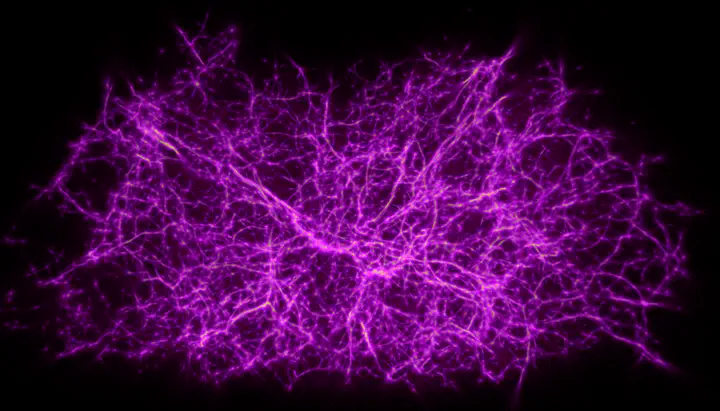Mediglot

PolyPhy is a GPU-oriented agent-based system for reconstructing and visualizing optimal transport networks defined over sparse data. Rooted in astronomy and inspired by nature, we have used an early prototype called Polyphorm to reconstruct the Cosmic web structure, but also to discover network-like patterns in natural language data. You can see an instructive overview of PolyPhy in our workshop and more details about our research here. Recent projects, such as Polyglot and Mediglot have focused on using PolyPhy to better visualize language embeddings.
Medicinal Language Embeddings
- Topics:
Large Language ModelsNLPEmbeddingsMedicine - Skills: Python, JavaScript, Data Science, Technical Communication
- Difficulty: Challenging
- Size: Large (350 hours)
- Mentors: Oskar Elek, Kiran Deol
This project aims to refine and enhance Mediglot, a web application for visualizing 3D medicinal embeddings, which extends the Polyglot app and leverages the PolyPhy toolkit for network-inspired data science. Mediglot currently enables users to explore high-dimensional vector representations of medicines (derived from their salt compositions) in a 3D space using UMAP, as well as analyze similarity through the innovative Monte-Carlo Physarum Machine (MCPM) metric. Unlike traditional language data, medicinal embeddings do not have an inherent sequential structure. Instead, we must work with the salt compositions of each medicine to create embeddings that are faithful to the intended purpose of each medicine.
This year, we would like to focus on exploring and integrating state-of-the-art AI techniques and algorithms to improve Mediglot’s clustering capabilities and its representation of medicinal data in 3D. The contributor will experiment with advanced large language models (LLMs) and cutting-edge AI methods to develop innovative approaches for refining clustering and extracting deeper insights from medicinal embeddings. Beyond LLMs, we would like to experiment with more traditional language processing methods to design novel embedding procedures. Additionally, we would like to experiment with other similarity metrics. While the similarity of two medicines depends on the initial embedding, we would like to examine the effects of different metrics on the kinds of insights a user can extract. Finally, the contributor is expected to evaluate and compare different algorithms for dimensionality reduction to enhance the faithfulness of the visualization and its interpretability.
The ideal contributor for this project has experience with Python (and common scientific toolkits such as NumPy, Pandas, SciPy). They will also need some experience with JavaScript and web development (MediGlot is distributed as a vanilla JS web app). Knowledge of embedding techniques for language processing is highly recommended.
Specific tasks:
- Closely work with the mentors to understand the context of the project and its detailed requirements in preparation for the proposal.
- Become acquainted with the tooling (PolyPhy, PolyGlot, Mediglot) prior to the start of the project period.
- Explore different embedding techniques for medicinal data (including implementing novel embedding procedures).
- Explore different dimensionality reduction techniques, with a focus on faithful visualizations.
- Document the process and resulting findings in a publicly available report.
Enhancing PolyPhy Web Application
- Topics:
Web DevelopmentUI/UX DesignFull Stack DevelopmentJavaScriptNext.jsNode.js - Skills: Full Stack Web Development, UI/UX Design, JavaScript, Next.js, Node.js, Technical Communication
- Difficulty: Challenging
- Size: Medium (175 hours)
- Mentors: Oskar Elek, Kiran Deol
This project aims to revamp and enhance the PolyPhy web platform to better support contributors, users, and researchers. The goal is to optimize the website’s UI/UX, improve its performance, and integrate Mediglot to provide users with a seamless experience in visualizing both general network structures and 3D medicinal embeddings.
The contributor will be responsible for improving the website’s overall look, feel, and functionality, ensuring a smooth and engaging experience for both contributors and end-users. This includes addressing front-end and back-end challenges, optimizing the platform for better accessibility, and ensuring seamless integration with Mediglot.
The ideal candidate should have experience in full-stack web development, particularly with Next.js, JavaScript, and Node.js, and should be familiar with UI/UX design principles. A strong ability to communicate effectively, both in writing and through code, is essential for this role.
Specific tasks:
- Collaborate with mentors to understand the project’s goals and the specific requirements for the website improvements.
- UI/UX Redesign:
- Redesign and enhance the website’s navigation, layout, and visual elements to create an intuitive and visually engaging experience.
- Improve mobile responsiveness for broader accessibility across devices.
- Website Performance & Stability:
- Identify and resolve performance bottlenecks, bugs, or issues affecting speed, stability, and usability.
- Mediglot Integration:
- Integrate the Mediglot web application with PolyPhy, ensuring seamless functionality and a unified user experience for visualizing medicinal data alongside general network reconstructions.
- Documentation:
- Document the development process, challenges, and solutions in a clear and organized manner, ensuring transparent collaboration with mentors and the community.
